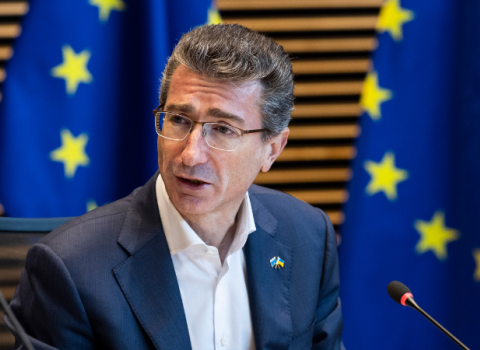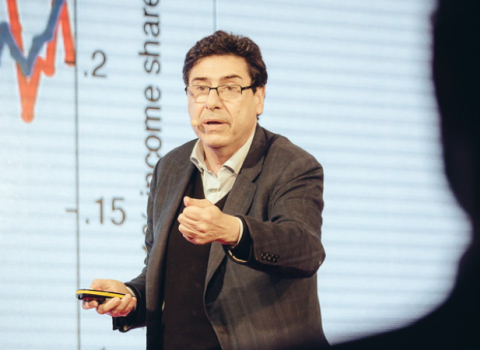Bernd Schäfer, CEO and Managing Director of EIT RawMaterials, explains why the proposed EU budget needs a concrete, funded and actionable path for securing essential raw materials.

Bernd Schäfer, CEO and Managing Director of EIT RawMaterials, during the EIT RawMaterials Summit 2025.
Photo credit: EIT RawMaterials
The new European Commission proposal for the EU’s Multiannual Financial Framework (MFF) for 2028–2034 is an ambitious €2 trillion roadmap to boost competitiveness, accelerate digital transformation and reinforce Europe’s defence capabilities. At EIT RawMaterials, we welcome the MFF’s broader ambition. The proposal reflects a necessary rethinking of Europe’s long-term investment priorities, and we are encouraged by the inclusion of instruments, such as the EU Competitiveness Fund (ECF) and Horizon Europe, which will be critical in shaping a more innovative and competitive Union.
However, for all its ambition, the MFF understates the foundational importance of critical and strategic raw materials (CRMs and SRMs). It fails to lay out a concrete, funded and actionable path for securing these materials, despite their central role in enabling every pillar of EU industrial, digital, climate and defence policy. This signals a troubling disconnect between strategic rhetoric and investment reality.
This is particularly stark when it comes to Europe’s defence ambitions, which are existentially dependent on secure access to defence-critical raw materials. From rare earth magnets in missile guidance systems to tungsten alloys, titanium and battery-grade metals for advanced platforms, these materials form the backbone of credible defence capabilities. Yet this issue remains conspicuously absent from current MFF negotiations. While raw materials are mentioned – for instance, under Specific activities to support resilience policies in Article 42 of the European Competitiveness Fund Regulation proposal – the scope is limited and far from sufficient. Contrast this with the 2024 report, The Future of European Competitiveness, by former ECB President and Italian Prime Minister Mario Draghi, which ranked raw materials as the second most strategically vital area for Europe, only behind energy.
In line with Draghi’s call to reverse a decade of underinvestment in innovation, the MFF does propose a promising step to nearly double funding for Horizon Europe to €175 billion. But unless matched by a serious commitment to raw materials security, these risks being undermined by material constraints and supply-chain dependencies.
Targeted investment in the raw materials value chain
To course-correct, Europe must embed broader and more integrated financial support for raw materials within the new budget matrix. That is why EIT RawMaterials is renewing its call for at least €4 billion in targeted investment under Horizon Europe to support innovation, circularity, skills and strategic partnerships across the raw materials value chain. This is not just an economic need, it is a sovereignty imperative.
More specifically, EIT RawMaterials calls for:
- The creation of a dedicated raw & advanced materials work programme within Horizon Europe, integrating innovation from mine to market;
- The establishment of funding mechanisms under the ECF, aligned to the objectives of the Critical Raw Materials Act (CRMA) and the Net Zero Industry Act (NZIA), supported by concrete implementation metrics;
- A dedicated critical raw materials fund, leveraging the capabilities of EIT RawMaterials and the strategic depth the European Raw Materials Alliance (ERMA) offers, to unlock offtake-backed strategic partnerships and secure CRMs supply to European industry;
- The creation of an unified EU raw materials funding gateway: a one-stop-shop platform that consolidates access to all relevant EU instruments, supported by shared due diligence and streamlined processes;
- A Europe-led global partnership mechanism for CRMs and SRMs, backed by offtake agreements and technology exchange, focusing on delivery – not declarations – with partner countries across Africa, Latin America, Central Asia, Australia and Europe, particularly high-potential regions, such as Greenland, prioritising materials most critical on the EU’s heat map;
- Long-term investment in skills and workforce development across the entire raw materials ecosystem.
The US and China take a more holistic approach
If Europe fails to act, it risks falling behind global peers and rivals. The United States and China are moving aggressively, each implementing whole-of-government strategies that combine targeted capital deployment, regulatory streamlining and rapid public-private coordination.
On 30 June 2025, the U.S. administration issued a Presidential Memorandum directing a coordinated, government-wide approach to funding and permitting for energy and critical raw material projects. It introduces a lead agency coordination framework and a centralised public funding platform, as well as a clear strategy for streamlining due diligence and reducing the administrative hurdles for applicants.
Europe, by contrast, has policy tools – but not integration. Some 60 strategic projects – 47 across Member States and 13 in partner countries – have already been identified and would help meet Europe’s defence and energy transition goals. But their success depends on faster permitting, simplified funding access and coordinated implementation, as envisioned in the CRMA.
Policy instruments, such as the CRMA, Horizon Europe, Strategic Technologies for Europe Platform, the European Climate Fund, InvestEU and ERMA represent significant strengths. Yet without a unified platform or a common governance framework, funding remains fragmented, and implementation will remain slow.
That is why EIT RawMaterials proposes the creation of a unified EU raw materials funding gateway, which would both reduce friction for project developers and signal to global markets and European industry that the EU is serious about turning raw materials strategy into reality.
As I outlined in my Five-Pillar Strategy at the EIT RawMaterials Summit in Brussels this May, Europe’s raw materials resilience depends on: (1) responsible extraction, (2) industrial circularity, (3) global partnerships, (4) innovation, and (5) future-proof skills. These pillars must now be structurally reflected in our long-term budget and funding architecture. They must explicitly include system-level circularity solutions – spanning design, reuse, recycling and urban mining and not merely extraction or substitution.
The next phase of MFF negotiations must bridge the gap between vision and implementation. Raw materials are not an accessory – they are the foundation of everything Europe wants to build, from semiconductors and batteries to defence systems, clean tech and AI. Failing to prioritise them risks weakening Europe’s strategic autonomy. The United States has already recognised that supply chains are security assets; Europe must act with similar urgency and cohesion.
With targeted investment, streamlined access, circular value chains, and whole-of-government coordination, we can - and must - turn raw materials into a competitive advantage for Europe’s future.





 A unique international forum for public research organisations and companies to connect their external engagement with strategic interests around their R&D system.
A unique international forum for public research organisations and companies to connect their external engagement with strategic interests around their R&D system.